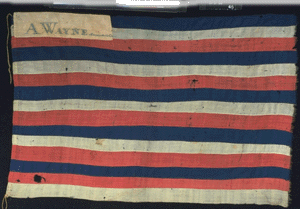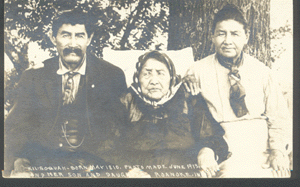Affidavit - Dr Perry G Moore August 30 1923

This flag at the present time measures 3 ft. 8 in. x 5 ft. 10 in. The original size was no doubt 3 ft. 6 in. x 6 ft. It is composed of fifteen stripes, red, white and blue, made of domestic bunting. The white linen field contains in place of stars, the inscription, "A. Wayne, Commander in Chief."
I first saw the flag in the summer of 1868. At that time a family by the name of Aveline, consisting of James Aveline, his Indian wife, three sons and two daughters, were living near the Wabash and Miami County Line, and on the south bank of the Wabash river. James Aveline, a Frenchman, was a brother of Frank Aveline, who built and owned the Aveline Hotel, at Ft. Wayne, that later burned with frightful loss of life.
In the summer of 1868, James Aveline was stricken with typhoid fever and was under my care; during the early days of his illness, he asked me to write a letter and address it to Mrs. Mary Aveline, Wm. Pratt, Ft. Wayne, Indiana, and describe his condition, and added, "she is my wife and she will come immediately." The following day she arrived and remained during his illness. The original white family consisted of Mr. and Mrs. James Aveline, one son and three daughters. The oldest daughter, Mrs. Wm. Pratt, died several years previous.
The Indian wife did not speak English but the white wife spoke the Indian language fluently. The two wives were very congenial and seemed on the best of terms. In a few days, the white wife observed that I was interested in the Indian relics about the house, and asked if I would enjoy seeing a lot of Indian clothing that the Indian wife had. I replied "yes". She asked her to show them to me. The exhibit consisted of clothing, parchment manuscripts, silver medals from George Washington, Thomas Jefferson, and many other articles that she had inherited from her grandfather, Chief She-Moc-E-Nish of Thorntown. Seeing my interest in the exhibit, she said there was another relic she presumed would interest me, that was owned by Mrs. Dixon, an aged Indian lady who lived about a quarter of a mile distant, a flag that was carried by Anthony Wayne, and that if I would remain until after dinner, they would both go with me to see it. I accepted the invitation and we visited the old lady's home and saw the flag. Mrs. Dixon was also a granddaughter of Chief She-Moc-E-Nish, and a cousin of the Indian Aveline wife. the Dixon family consisted of herself and her daughter, Mary Dixon.
Later, I become their physician and made several attempts to negotiate a purchase of the flag and asked her on several occasions to make a price that would buy it. She always replied through her interpreter Mary, that she never would part with the flag under any circumstances because of its having been associated with her grandfather, Chief She-Moc-E-Nish and also with the treaty held at Greenville. I finally ceased my efforts and awaited future developements.
In the course of time, she was gathered to her Fathers in the Happy Hunting Ground. Her daughter Mary, being the only heir, took possession of her mother's effect and soon married a white man. Mary did not hold the flag with the intense reverence that was exhibited by her mother, and as she needed funds to meet living expenses, she asked me if I still wanted to buy the old flag. I asked for her price, she told me, and the transfer was made.
I asked her for its history. She replied, "I do not know, only that my great grandfather, Chief She-Moc-E-Nish, captured it from Anthony Wayne," and then added that if I could see Kil-So-Quah, who was also a granddaughter of Chief She-Moc-E-Nish, that she could tell me all about it as she had the flag for a number of years; that she lived at Roanoke about fifteen miles from Ft. Wayne; that she was over eighty years old, growing feeble and was unable to speak the English language.

Kilsoquah in the center, 1913.
She advised me, because of her advanced age, to see her as soon as possible. Not being able to get an interpreter and see her at the same time, years passed by and I, presuming she had gone to the Happy Hunting Ground, concluded that the opportunity to secure the history was lost. I was living at Rich Valley at this time, six miles west of Wabash. In 1887 I moved to Wabash. Soon after, I noticed in the evening paper that the Indian Princess, Kil-So-Quah of Roanoke was in Wabash attending court to defend the title of her home against John Roach of Huntington: That the trial was the next day and Chief Gabriel Godfrey of Peru was court interpreter. Being well acquainted with Chief Godfrey, I met him at the train and made known my desire to get the history of the flag. He said he would be glad to assist me in every way possible. We found Kil-So-Quah in the court house and after he told her who I was, I asked did she know anything about an old Anthony Wayne Flag. She replied that she knew all about it, and that she had it for many years but had loaned it to her cousin, Mrs. Dixon, and that it was burned in her (Mrs. Dixon's) teepee. I asked, "would you know the flag if you would see it?" She replied, "Yes, but it was burned." My home only being three squares from the court house, I soon brought the flag and laid it on her lap with the field uppermost; she gazed intently upon it for a moment, then unfolding it, she held it before her eyes and with a happy recognition, her face brightened, her eyes sparkled,and the expression could not have been more pronounced had she met a long lost sister. Turning to Chief Godfrey she said, "this is the flag; they lied to me when they said it was burned." She then followed the lines of sewing on the stripes back and forth, turned it over and followed the lines on the other side, examined the field, looked at the buckskin string and again said, "this is the flag." Then folding it tenderly, she held it to her face and with tears trickling down her aged cheeks, she kissed the flag twice and handing it to Chief Godfrey said, "tell the Doctor I am glad he has got it, for he will take good care of it."
It being court time, I was unable to continue the interview longer. Her son, Anthony Revarre (the Indian name of Revarre is Kil-So-Quah and in the Indian language means Setting Sun) being with her, I told him I would like to visit their home and talk more with his mother concerning the flag. He replied that they would be very glad to have me at any time. I then arranged to go the following Sunday when he could be at home to act as interpreter and complete the history of the flag.
Taking my son Perry, who was reporter for one of our city papers, we made the trip to their quaint old Indian home at Roanoke, twenty five miles east of Wabash when the following interview occurred, with her son Anthony acting as interpreter.
"Where did you get the flag?" Answer. "After the death of my grandfather She-Moc-E-Nish at Thorntown. It came to me in line of his descendant." "Where did your grandfather get it?" Answer. "Before the Treaty of Peace was held at Greenville, Ohio, in 1795. George Washington ordered Anthony Wayne to have the flag made, and after the Treaty of Peace was signed, to present it to the Chief of the Miami Nation (She-Moc-E-Nish) and say, "keep this flag in sight and as often as you see it, remember we are friends."
I asked why they told her the flag was burned. She answered, "my grandmother, She-Moc-E-Nish's first wife, was a Miami and after her death, She-Moc-E-Nish married for his second wife a member of the Weea Tribe, to which two daughters were born who became mothers of Mrs. James Aveline and Mrs. Dixon, living in Miami County, Indiana, both cousins of mine. I later loaned the flag to Mrs. Dixon and because of the belief (superstition) that the possession of the flag by either tribe meant good luck to the tribe, the flag was reported burned, thus enabling Mrs. Dixon to continue possession of the flag."
Kil-So-Quah was known by her tribe as the Indian princess, and was also the granddaughter of Chief Little Turtle. I visited her at her Indian home on several occasions and always found her memory retentive and especially clear on all subjects relating to her early life. Her hair was jet black, sparkling eyes, and no indications of senility, excepting she had grown heavy and walked with the assistance of two canes.
She was born at what is known as the Forks of the Wabash, near Huntington, May (day not known) 1810. On July 4th, 1910, the people of Roanoke gave her the one hundredth anniversary of her life. The attendance was estimated at three thousand people. She died September 4th, 1915, age 105 years, the last full blood of the Miami tribe.
The foregoing items were all given me by Kil-So-Quah herself.
Very respectfully,
Dr. Perry G. Moore
Dr. Perry G. Moore being first duly sworn upon his oath deposes and says that he was born in Gales Mills, Cuyahoga County, Ohio, March 28th. 1845. That he moved to Rich Valley, Wabash County, Indiana, on November 18th. 1866, and that he has been in the active practice of medicine in the community since, and has since September 1887, lived in Wabash, Wabash County, Indiana.
That the statements contained in this foregoing manuscript concerning the Anthony Wayne Flag are true and he further sayeth not.
Signed, Dr. Perry G. Moore, August 30, 1923.
